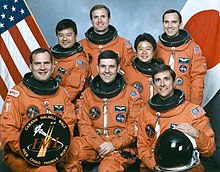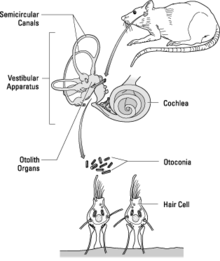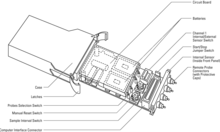
Spacelab was a reusable laboratory developed by European Space Agency (ESA) and used on certain spaceflights flown by the Space Shuttle. The laboratory comprised multiple components, including a pressurized module, an unpressurized carrier, and other related hardware housed in the Shuttle's cargo bay. The components were arranged in various configurations to meet the needs of each spaceflight.

STS-61-A was the 22nd mission of NASA's Space Shuttle program. It was a scientific Spacelab mission, funded and directed by West Germany – hence the non-NASA designation of D-1. STS-61-A was the ninth and last successful flight of Space Shuttle Challenger before the disaster. STS-61-A holds the current record for the largest crew—eight people—aboard any single spacecraft for the entire period from launch to landing.

STS-41 was the 36th Space Shuttle mission and the eleventh mission of the Space Shuttle Discovery. The four-day mission had a primary objective of launching the Ulysses probe as part of the "International Solar Polar Mission" (ISPM).

STS-42 was a NASA Space Shuttle Discovery mission with the Spacelab module. Liftoff was originally scheduled for 8:45 EST on January 22, 1992, but the launch was delayed due to weather constraints. Discovery successfully lifted off an hour later at 9:52:33 EST. The main goal of the mission was to study the effects of microgravity on a variety of organisms. The shuttle landed at 8:07:17 PST on January 30, 1992, on Runway 22, Edwards Air Force Base, California. STS-42 was the first of two flights in 1992 of Discovery, the second of which occurred during STS-53, which launched on December 2, 1992. The mission was also the last mission of the Space Shuttle Discovery to have a seven-member crew until STS-82, which was launched on February 11, 1997.
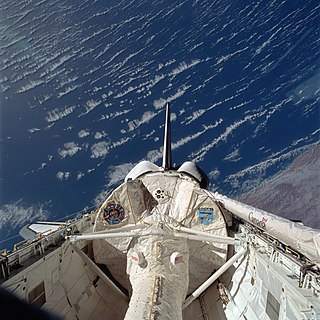
STS-47 was NASA's 50th Space Shuttle mission of the program, as well as the second mission of the Space Shuttle Endeavour. The mission mainly involved conducting experiments in life and material sciences inside Spacelab-J, a collaborative laboratory inside the shuttle's payload bay sponsored by NASA and the National Space Development Agency of Japan (NASDA). This mission carried Mamoru Mohri, the first Japanese astronaut aboard the shuttle, Mae Jemison, the first African-American woman to go to space, and the only married couple to fly together on the shuttle, Mark C. Lee and Jan Davis, contrary to NASA policy.

STS-58 was a NASA mission flown by Space Shuttle Columbia launched from Kennedy Space Center, Florida, on October 18, 1993. The missions was primarily devoted to experiments concerning the physiological effects in space. This was the first in-flight use of the "Portable In-flight Landing Operations Trainer" (PILOT) simulation software. It was also the last time Columbia would land at Edwards Air Force Base, California.

STS-85 was a Space Shuttle Discovery mission to perform multiple space science packages. It was launched from Kennedy Space Center, Florida, on 7 August 1997. A major experiment was the CRISTA-SPAS free-flyer which had various telescopes on board.

STS-70 was the 21st flight of the Space Shuttle Discovery, and the last of 7 shuttle missions to carry a Tracking and Data Relay Satellite (TDRS). This was the first shuttle mission controlled from the new mission control center room at the Johnson Space Center in Houston.

STS-69 was a Space Shuttle Endeavour mission, and the second flight of the Wake Shield Facility (WSF). The mission launched from Kennedy Space Center, Florida on 7 September 1995. It was the 100th successful crewed NASA spaceflight, not including X-15 flights.

STS-79 was the 17th flight of Space Shuttle Atlantis, and the 79th mission of the Space Shuttle program. The flight saw Atlantis dock with the Russian space station Mir to deliver equipment, supplies and relief personnel. A variety of scientific experiments were also conducted aboard Atlantis by her crew. It was the first shuttle mission to rendezvous with a fully assembled Mir, and the fourth rendezvous of a shuttle to the space station.

STS-83 was a NASA Space Shuttle mission flown by Columbia. It was a science research mission that achieved orbit successfully, but the planned duration was a failure due to a technical problem with a fuel cell that resulted in the abort of the 15 day duration. Columbia returned to Earth just shy of four days. The mission was re-flown as STS-94 with the same crew later that year.

STS-94 was a mission of the United States Space Shuttle Columbia, launched on 1 July 1997.

STS-90 was a 1998 Space Shuttle mission flown by the Space Shuttle Columbia. The 16-day mission marked the last flight of the European Space Agency's Spacelab laboratory module, which had first flown on Columbia on STS-9, and was also the last daytime landing for Columbia.

STS-95 was a Space Shuttle mission launched from Kennedy Space Center, Florida on 29 October 1998, using the orbiter Discovery. It was the 25th flight of Discovery and the 92nd mission flown since the start of the Space Shuttle program in April 1981. It was a highly publicized mission due to former Project Mercury astronaut and United States Senator John H. Glenn Jr.'s return to space for his second space flight. At age 77, Glenn became the oldest person to go into space, a record that remained unbroken for 23 years until 82-year-old Wally Funk flew on a suborbital flight on Blue Origin NS-16, launching on 20 July 2021, which in turn was broken by William Shatner at age 90 on 13 October 2021. Glenn, however, remains the oldest person to reach Earth orbit. This mission is also noted for inaugurating ATSC HDTV broadcasting in the U.S., with live coast-to-coast coverage of the launch. In another first, Pedro Duque became the first Spaniard in space.

STS-105 was a mission of the Space Shuttle Discovery to the International Space Station, launched from Kennedy Space Center, Florida, 10 August 2001. This mission was Discovery's final mission until STS-114, because Discovery was grounded for a refit, and then all Shuttles were grounded in the wake of the Columbia disaster. The refit included an update of the flight deck to the glass cockpit layout, which was already installed on Atlantis and Columbia.

Chiaki Mukai is a Japanese physician and JAXA astronaut. She was the first Japanese woman in space, the first Japanese citizen to have two spaceflights, and the first Asian woman in space. Both were Space Shuttle missions; her first was STS-65 aboard Space Shuttle Columbia in July 1994, which was a Spacelab mission. Her second spaceflight was STS-95 aboard Space Shuttle Discovery in 1998. In total she has spent 23 days in space.

Donald Alan Thomas is an American engineer and a former NASA astronaut.

The Minus Eighty-Degree Laboratory Freezer for ISS (MELFI) is a European-built experiment storage freezer for the International Space Station. It comprises four independent dewars which can be set to operate at different temperatures. Currently temperatures of −80 °C, −26 °C, and +4 °C are used during on-orbit ISS operations. Both reagents and samples will be stored in the freezer. As well as storage the freezer is designed to be used to transport samples to and from the ISS in a temperature controlled environment. The total capacity of the unit is 300 litres.
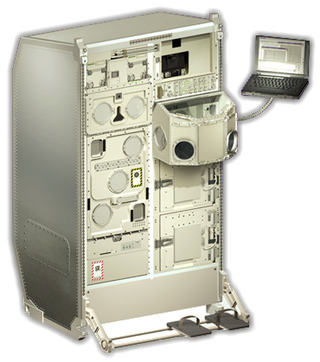
Biolab is a single-rack multi-user science payload designed for use in the Columbus laboratory of the International Space Station. Biolab support biological research on small plants, small invertebrates, microorganisms, animal cells, and tissue cultures. It includes an incubator equipped with centrifuges in which the preceding experimental subjects can be subjected to controlled levels of accelerations.

The International Space Station is a platform for scientific research that requires one or more of the unusual conditions present in low Earth orbit. The primary fields of research include human research, space medicine, life sciences, physical sciences, astronomy and meteorology. The 2005 NASA Authorization Act designated the American segment of the International Space Station as a national laboratory with the goal of increasing the use of the ISS by other federal agencies and the private sector.


